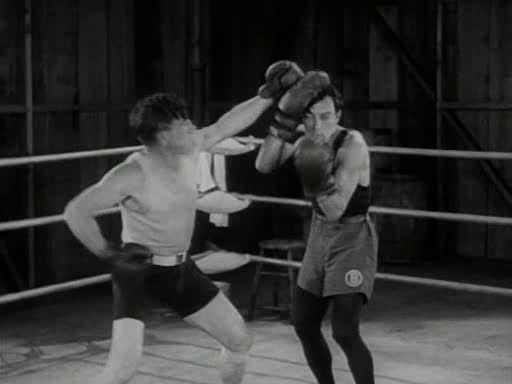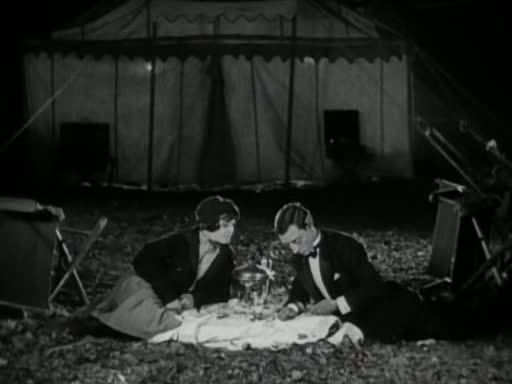
Battling Butler follows a familiar template for many of Buster Keaton's features, with Keaton's character starting out inept and gradually gaining in proficiency so he can get the girl. This is one of his features that actually has a bit more of a plot, with Keaton playing Alfred Butler, a snooty society heir with more than a little similarity to his hapless rich kid in The Navigator. When his parents want to toughen up the spoiled brat, they send him out into the woods for a camping trip, accompanied by a manservant (the always funny Snitz Edwards) who makes the trip anything but roughing it.
The camping scenes provide a barrage of great gags, many of them about all the amenities that Butler has lugged with him into the wilderness. But the best moment is Butler's hilarious attempt at fishing, which then leads into an equally inept attempt to shoot a duck with a shotgun while balancing, standing up, on a tiny boat. Then Butler meets a country girl (Sally O'Neil), and again as in The Navigator, immediately decides to get married. In order to impress her tough-guy family, though, he has to pose as his namesake, the boxer "Battling" Butler, which ignites the series of misidentifications and misunderstandings that drive the rest of the film.
The scenes of Butler training so that he can go through with his ruse are typically inspired, with Keaton's agility and deadpan unflappability adding to the slapstick joys of these scenes. There's lots of fun with the ropes of the boxing ring, with Keaton bouncing off and around them, ducking under, getting tangled in them or literally tied to them, sliding around on the floor, all in a desperate attempt to get into the ring — followed quickly by a series of even more desperate attempts to get back out of the ring. It's not quite the most madcap or energetic of Keaton's physical performances, but it's a typically satisfying sequence of gags as the inept trainee leaps fearfully into the arms of his trainer, gets pounded, runs around the ring and keeps throwing wild punches while keeping his gaze locked, not on his opponent, but on the trainer who's trying to instruct him.

There are a few nice moments here where Keaton uses frames within the frame to highlight the separation between Butler and the girl he's married but has to continue lying to. Right after their wedding, he has to rush off to pretend to train for a fight, and as he drives away from her, the girl's face is framed in the oval back window of the car, receding into the distance as the car pulls out. Later, when she unexpectedly shows up at a training session, Butler sees her face framed in the crook of his sparring partner's arm. In the next shot, Keaton reverses the perspective so that Butler is framed in the same angular hole between the other boxer's body and arm. It's a great diptych, which visually encapsulates the idea that Butler's boxing ruse is keeping the couple apart, literally standing between them so that they can only see one another framed by a boxer's arm.
Battling Butler isn't one of Keaton's best works, and its climax is somewhat lacking in the charm and humor of the rest of the film, as well as the usual high-energy hijinks that so often erupt in the last reel of his films — though the last shot, of Keaton walking arm-in-arm with his gal while wearing a top hat, boxing trunks and gloves, is a great final image. This is mid-level Keaton, which of course means that it's still very funny, packed with fantastic set pieces and visual/physical humor.

2 comments:
Yes I completely agree that this is "mid-level" Keaton, and that is does contain some priceless set pieces and physical humor. The reason why the film has more of a plot surely has something to do that it is that exceedingly rare instances where it was actually based on a stage play, and a successful one at that, running for 313 performances, and starring Charlie Ruggles.
It is certainly worth comparing the film with Chaplin's CITY LIGHTS, a screen masterwork, that features a famed boxing sequences. Where Chaplin deftly avoids his opponents by fancy footwork and acrobatics, Keaton, the more physical actor, absorbed more pain, a fact that purportedly sidelined him after the completion of some of the film's boxing segments.
Against all odds and expectations, BATTLING BUTLER was the most popular Keaton feature back in the day, and Keaton himself, who considered it one of his favorites was not at all displeased.
Wondering essay here in your outstanding Keaton series.
Thanks, Sam. Even mid-level Keaton is lots of fun obviously, and there's much here to appreciate even if it's not on the level of his very best pictures.
Post a Comment